New Delhi: India’s GST collection rose by 18 per cent in February 2022 on a year-on-year basis to Rs 133,026 crore, official data showed on Tuesday. This is the fifth time the GST collection has crossed the Rs 1.30 lakh crore mark.
“The revenues for the month of February 2022 are 18 per cent higher than the GST revenues in the same month last year and 26 per cent higher than the GST revenues in February 2020,” the Ministry of Finance said in a statement.
“During the month, revenues from import of goods was 38 per cent higher and the revenues from domestic transaction (including import of services) are 12 per cent higher than the revenues from these sources during the same month last year.” However, on a sequential basis, last month’s collections were slightly lower than those of January 2022. In January 2022, the collection had stood at Rs 138,394 crore.
According to the ministry, February, being a 28-day month, normally witnesses revenues lower than in January. “This high growth during February 2022 should also be seen in the context of partial lockdowns, weekend and night curfews and various restrictions that were put in place by states due to the omicron wave, which peaked around January 20.”
Besides, the ministry noted that GST cess collection crossed Rs 10,000 crore mark, which signifies recovery of certain key sectors, especially automobile sales.
Furthermore, it cited that out of the gross GST revenue collected in February 2022, CGST accounted for Rs 24,435 crore, SGST was Rs 30,779 crore, IGST Rs 67,471 crore and cess stood at Rs 10,340 crore. “GST revenues remained expectedly resilient in February 2022, as the third wave had a limited impact on industrial activity and GST e-way bill generation in January 2022,” said Aditi Nayar, Chief Economist, ICRA.
“WIth the robust rise in GST e-way bill generation in February 2022, we expect a sequential uptick in the GST revenues in the current month. Moreover, CGST revenues are likely to exceed the Government of India’s FY2022 RE by up to Rs 0.3 trillion, complementing the anticipated overshooting in direct taxes.”
(IANS)



















